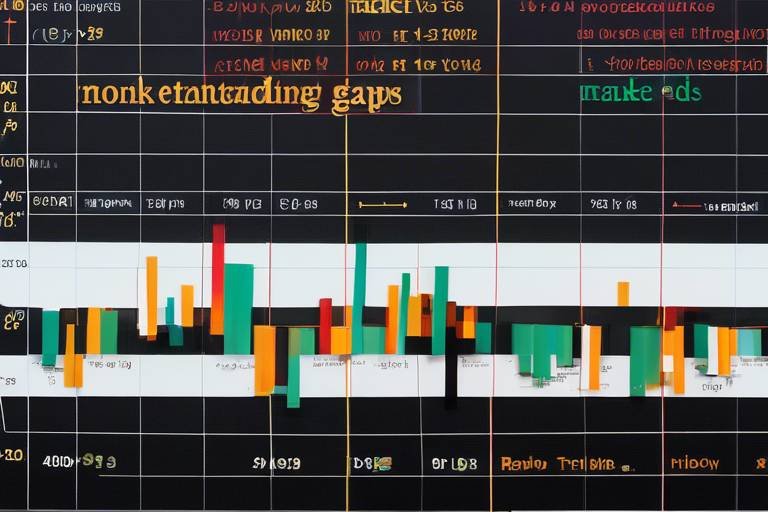How to Assess the Volatility of Emerging Cryptocurrencies
In today's fast-paced digital landscape, emerging cryptocurrencies are capturing the attention of investors, traders, and tech enthusiasts alike. But with great opportunity comes great risk, and understanding how to assess the volatility of these digital assets is crucial for anyone looking to dive into the crypto market. Volatility refers to the degree of variation in trading prices over time, and in the world of cryptocurrencies, this can mean wild price swings that can occur within minutes or hours. So, how do you navigate this rollercoaster of price movements? In this article, we will explore various methods and tools to evaluate the volatility of emerging cryptocurrencies, shedding light on their significance in making informed investment decisions and conducting market analysis.
Cryptocurrency volatility is a term that describes the rapid price fluctuations that can occur within short timeframes. Unlike traditional assets, cryptocurrencies can experience significant price changes based on a myriad of factors. Imagine standing on a bridge, watching a river flow beneath you; some days it’s calm, while other days it’s raging with strong currents. This is akin to the cryptocurrency market, where prices can surge or plummet dramatically. For investors, this volatility can be a double-edged sword. On one hand, it offers opportunities for substantial gains; on the other, it poses risks of severe losses. Understanding this volatility is essential for anyone looking to invest in cryptocurrencies.
Several factors contribute to the volatility of cryptocurrencies, and recognizing these elements can help investors make more informed decisions. The cryptocurrency market is influenced by market sentiment, regulatory news, and technological developments. Each of these factors can trigger price movements that might seem unpredictable at first glance. For instance, when a widely recognized figure endorses a cryptocurrency, it can lead to a surge in buying activity, while negative regulatory news can trigger panic selling. Understanding these dynamics is key to navigating the volatile waters of the cryptocurrency market.
Market sentiment plays a crucial role in cryptocurrency volatility. Think of it as the mood of the market—when traders feel optimistic, prices tend to rise, and when they are pessimistic, prices often drop. This subsection explores how the emotions and collective behavior of traders influence price changes and market trends. Investors often rely on sentiment analysis tools to gauge the overall mood of the market. For example, if a significant number of traders are expressing excitement about a new cryptocurrency project, it might indicate a potential price increase. Conversely, widespread fear can signal a downturn.
News events can trigger significant price swings in cryptocurrencies. A single headline can send prices soaring or crashing down. For instance, when major exchanges list a new cryptocurrency, it often leads to a surge in demand, driving up the price. On the flip side, negative news, such as security breaches or regulatory crackdowns, can lead to sharp declines. Investors must stay informed and monitor news sources closely to understand how these events might impact their investments.
Social media platforms have become powerful tools in the cryptocurrency landscape, amplifying market sentiment and leading to increased volatility. Tweets from influential figures or viral posts can create waves of buying or selling activity. For example, a single tweet from a celebrity endorsing a cryptocurrency can lead to a dramatic price increase within hours. Therefore, monitoring social media trends and discussions can provide valuable insights into market movements.
Technical analysis involves using historical price data to forecast future price movements. Investors often rely on various tools and indicators to assess cryptocurrency volatility. Common tools include moving averages, Bollinger Bands, and Relative Strength Index (RSI). Each of these tools provides unique insights into price trends and potential reversals. For example, Bollinger Bands can help identify overbought or oversold conditions, signaling potential price corrections. By employing these technical analysis tools, investors can make more informed decisions in a volatile market.
Investors must implement effective risk management strategies to navigate the unpredictable waters of cryptocurrency volatility. Without a solid plan, the potential for significant losses increases dramatically. Here are a couple of approaches that can help minimize risks:
Diversification is a key strategy in managing risk. By spreading investments across different cryptocurrencies, investors can mitigate the impact of volatility on their overall portfolio. Imagine a fruit basket filled with apples, oranges, and bananas; if one type of fruit goes bad, you still have others to enjoy. Similarly, diversifying your crypto investments can provide a safety net during turbulent times.
Stop-loss orders are essential tools for protecting investments. These orders automatically sell a cryptocurrency when it reaches a predetermined price, limiting potential losses during volatile market conditions. Setting effective stop-loss orders requires careful consideration of market trends and individual risk tolerance. By implementing these orders, investors can protect their capital and minimize the emotional stress that often accompanies rapid price fluctuations.
- What is cryptocurrency volatility? Cryptocurrency volatility refers to the rapid price fluctuations that can occur within short timeframes, impacting investment decisions.
- How can I assess the volatility of a cryptocurrency? You can assess volatility using market sentiment analysis, news impact, social media trends, and technical analysis tools.
- What are some risk management strategies for cryptocurrency investing? Key strategies include diversification and setting stop-loss orders to protect your investments from significant losses.

Understanding Cryptocurrency Volatility
Cryptocurrency volatility is one of the most talked-about characteristics of digital currencies, and for good reason. It refers to the rapid and often unpredictable price fluctuations that can occur within very short timeframes. Imagine a roller coaster ride—one moment you're soaring high, and the next, you're plummeting down. This is essentially what happens in the cryptocurrency market. Prices can skyrocket or crash within hours, leaving investors both exhilarated and anxious. Understanding this volatility is crucial for anyone looking to invest in cryptocurrencies, as it directly impacts investment decisions and overall market analysis.
But what exactly causes these wild price swings? Well, volatility is not just a random occurrence; it is influenced by a myriad of factors. For starters, the market is still relatively young and less mature compared to traditional financial markets. This youthfulness means that even small amounts of capital can lead to significant price changes. Additionally, the lack of regulation in many areas contributes to this instability. When news breaks—whether it's positive or negative—it can send shockwaves through the market, resulting in rapid price adjustments.
Another key aspect to consider is the investor base. The cryptocurrency market attracts a diverse group of investors, from seasoned traders to newcomers who may not fully understand the market dynamics. This mix can lead to irrational trading behaviors driven by fear or greed, further amplifying volatility. Moreover, the decentralized nature of cryptocurrencies means that they are not tied to any physical asset or government policy, which adds another layer of unpredictability.
To illustrate this, let’s look at some examples of how volatility can manifest in the cryptocurrency market. For instance, a sudden regulatory announcement can cause prices to plummet. Conversely, a major company announcing that it will accept a particular cryptocurrency can lead to a dramatic increase in value. Here's a quick comparison of two cryptocurrencies and their volatility over a specified period:
| Cryptocurrency | Price Change (%) | Time Frame |
|---|---|---|
| Bitcoin (BTC) | +20% | 24 hours |
| Ethereum (ETH) | -15% | 24 hours |
In this table, you can see how Bitcoin experienced a significant price increase while Ethereum faced a decline—all within the same time frame. Such differences highlight the varying levels of volatility among cryptocurrencies. Therefore, understanding volatility is not just about recognizing price swings; it’s about being able to anticipate how these swings can affect your investments and making informed decisions based on that knowledge.
In summary, cryptocurrency volatility is a double-edged sword. While it presents opportunities for high returns, it also poses substantial risks. Investors must arm themselves with knowledge and tools to navigate this unpredictable landscape. The more you understand about volatility, the better equipped you'll be to make strategic investment choices that align with your financial goals.

Factors Influencing Volatility
When diving into the world of cryptocurrencies, one cannot ignore the dynamic nature of their price movements. Volatility is like a roller coaster ride; it can be thrilling and terrifying at the same time. But what exactly fuels this wild ride? Several factors contribute to the volatility of cryptocurrencies, each playing a unique role in shaping market behavior. Understanding these elements is crucial for anyone looking to invest in this digital frontier.
One of the most significant factors influencing volatility is market sentiment. The collective mood of traders can swing from optimism to fear in the blink of an eye. Imagine a crowd at a concert; when the lead singer hits the high note, cheers erupt, and the energy surges. Conversely, if the singer misses a note, the atmosphere can sour instantly. Similarly, in the crypto market, positive news can send prices soaring, while negative reports can lead to swift declines.
Another crucial element is regulatory news. Governments around the world are still figuring out how to handle cryptocurrencies. When a country announces new regulations—whether they are supportive or restrictive—it can send shockwaves through the market. For instance, a positive regulatory framework may boost investor confidence, while harsh regulations can lead to panic selling. The uncertainty surrounding regulations makes it essential for investors to stay informed and agile.
Technological developments also play a pivotal role in influencing volatility. Innovations in blockchain technology or the introduction of new cryptocurrencies can create excitement, leading to increased trading activity. Think of it like a new smartphone release; early adopters rush to buy it, driving demand and prices up. However, technological failures or security breaches can have the opposite effect, causing prices to plummet as trust diminishes.
Furthermore, the liquidity of a cryptocurrency can significantly impact its volatility. Cryptocurrencies with lower trading volumes tend to experience more dramatic price swings because even small trades can lead to significant price changes. It’s similar to a small boat on a vast ocean; a gentle breeze can cause it to sway wildly. In contrast, larger, more established cryptocurrencies usually have higher liquidity, leading to more stable price movements.
Lastly, the influence of social media cannot be overlooked. Platforms like Twitter, Reddit, and Facebook have become hotbeds for cryptocurrency discussions. A single tweet from a prominent figure can send a cryptocurrency's price soaring or crashing. Social media can amplify sentiments, creating a feedback loop that exacerbates volatility. It’s like a rumor spreading through a school; once it catches on, it can lead to widespread reactions and consequences.
In summary, the volatility of cryptocurrencies is influenced by a multitude of factors including market sentiment, regulatory news, technological developments, liquidity, and social media dynamics. Each of these elements interacts in complex ways, creating a landscape that is both exciting and challenging for investors. Understanding these factors is not just beneficial; it's essential for making informed investment decisions in the ever-evolving world of cryptocurrencies.
- What is cryptocurrency volatility?
Cryptocurrency volatility refers to the rapid and significant price fluctuations that can occur within short timeframes. - What factors contribute to cryptocurrency volatility?
Factors include market sentiment, regulatory news, technological advancements, liquidity, and social media influence. - How can I manage risk in a volatile market?
Implementing strategies like diversification and setting stop-loss orders can help mitigate risks associated with volatility.

Market Sentiment Analysis
Market sentiment is like the weather in the world of cryptocurrencies; it can change in an instant. Just as a sunny day can quickly turn into a storm, the emotions and attitudes of traders and investors can swing from optimism to fear, influencing the prices of digital currencies. Understanding market sentiment is crucial for anyone looking to navigate the turbulent waters of cryptocurrency investments. So, what exactly is market sentiment, and why should you care?
At its core, market sentiment refers to the overall attitude of investors toward a particular asset or market. In the case of cryptocurrencies, this sentiment can be driven by various factors, including news events, social media trends, and even the performance of traditional financial markets. When sentiment is positive, you might see a surge in buying activity, pushing prices higher. Conversely, negative sentiment can lead to panic selling, causing prices to plummet. It's a classic case of herd behavior, where the collective emotions of a group can significantly impact market dynamics.
One of the most effective ways to gauge market sentiment is through sentiment analysis, which involves evaluating public opinions and emotions about cryptocurrencies. This can be done by analyzing social media posts, news articles, and forum discussions. For example, platforms like Twitter and Reddit can provide real-time insights into how investors feel about specific cryptocurrencies. If you notice a lot of positive chatter about a particular coin, it may indicate that traders are feeling bullish, potentially leading to price increases. On the flip side, a wave of negative comments could signal impending price drops.
Moreover, market sentiment is often influenced by key events, such as regulatory announcements or technological advancements. For instance, if a country announces favorable regulations for cryptocurrency trading, you might see a spike in positive sentiment, as investors feel more secure about entering the market. Conversely, news of a major hack or regulatory crackdown can trigger fear and uncertainty, leading to increased volatility.
To illustrate the impact of market sentiment on cryptocurrency prices, consider the following table:
| Event | Market Sentiment | Price Movement |
|---|---|---|
| Positive Regulatory News | Bullish | Price Surge |
| Major Exchange Hack | Bearish | Price Drop |
| Celebrity Endorsement | Bullish | Price Increase |
| Market Crash in Traditional Assets | Bearish | Price Decline |
As you can see, market sentiment can lead to dramatic price movements, making it essential for investors to stay attuned to the emotional climate surrounding their investments. By monitoring sentiment indicators, such as the Fear & Greed Index or social media analytics tools, investors can make more informed decisions and potentially capitalize on price swings. Remember, in the world of cryptocurrencies, being aware of the mood can be just as important as understanding the numbers.
In conclusion, market sentiment analysis is a powerful tool for anyone looking to invest in cryptocurrencies. By keeping an eye on public perception and emotional trends, you can better navigate the unpredictable nature of this exciting market. So, the next time you're considering an investment, take a moment to assess the sentiment—after all, it might just save you from a stormy investment!
- What is market sentiment? Market sentiment refers to the overall attitude of investors toward a particular asset or market, influenced by emotions and external events.
- How can I analyze market sentiment? You can analyze market sentiment by monitoring social media, news articles, and using sentiment analysis tools to gauge public opinion.
- Why is market sentiment important in cryptocurrency trading? It can significantly affect price movements, helping investors make more informed decisions about buying or selling assets.

News Impact on Prices
In the fast-paced world of cryptocurrencies, news can act as a double-edged sword. It has the power to propel prices to new heights or send them tumbling down, often within minutes. For investors, understanding how news impacts prices is crucial in navigating this volatile landscape. When a major development occurs—be it a regulatory change, a technological breakthrough, or a partnership announcement—the ripple effects can be felt almost instantly across the market. This is not just speculation; it's a reality that many traders have experienced firsthand.
Consider this: a positive news story about a cryptocurrency can lead to an influx of buyers, driving prices up as demand surges. Conversely, negative news can trigger panic selling, causing prices to plummet. For instance, when a country announces a crackdown on cryptocurrency trading, the market often reacts swiftly, leading to significant price drops. The emotional response from traders can create a feedback loop, amplifying the initial impact of the news.
Moreover, the timing of news releases plays a pivotal role in how prices react. If a significant announcement is made during peak trading hours, the effects can be more pronounced due to higher trading volumes. On the other hand, news released during off-peak hours may not have the same immediate impact, although it can still influence market sentiment in the long run.
To illustrate the impact of news on cryptocurrency prices, let's look at a hypothetical scenario:
| News Event | Price Before | Price After | Change (%) |
|---|---|---|---|
| Positive Partnership Announcement | $100 | $120 | +20% |
| Regulatory Crackdown News | $100 | $70 | -30% |
| Major Exchange Hack | $100 | $50 | -50% |
As shown in the table, the impact of news can be dramatic and swift. Traders must be vigilant and stay informed, as even minor news can lead to unexpected price volatility. Social media platforms, news outlets, and cryptocurrency forums are often the first places where information spreads, making it essential for investors to monitor these channels closely.
In conclusion, the influence of news on cryptocurrency prices is undeniable. It shapes market sentiment and can lead to rapid price fluctuations. By staying informed and understanding the implications of news events, investors can better position themselves to navigate the unpredictable waters of cryptocurrency trading.
- How quickly can news affect cryptocurrency prices? Prices can react within minutes of a news announcement, depending on the nature of the news and market conditions.
- Should I react immediately to news events? While it's important to stay informed, immediate reactions can lead to impulsive decisions. It's wise to analyze the news and its potential impact before acting.
- Where can I find reliable cryptocurrency news? Trusted sources include reputable financial news websites, official cryptocurrency project announcements, and well-known social media influencers in the crypto space.

Social Media Influence
In today's digital age, social media has become a powerful force in shaping public perception and influencing market trends, especially in the realm of cryptocurrencies. The rapid dissemination of information through platforms like Twitter, Reddit, and Facebook can lead to swift and dramatic price movements. Imagine social media as a double-edged sword; on one side, it can ignite enthusiasm and drive prices up, while on the other, it can foster panic and lead to sharp declines. This duality makes understanding social media's influence on cryptocurrency volatility essential for any investor.
One of the most significant aspects of social media's impact is the way it aggregates and amplifies market sentiment. When a cryptocurrency gains traction on platforms like Twitter, it can attract a wave of new investors who are eager to jump on the bandwagon. This phenomenon is often referred to as "FOMO," or the fear of missing out. As more people buy into a trending cryptocurrency, the price can skyrocket, creating a feedback loop of increasing interest and investment. Conversely, negative sentiment can spread just as quickly, leading to panic selling and steep price drops.
To illustrate this influence, consider the following table that highlights some key events where social media played a pivotal role in price changes:
| Event | Platform | Price Change (%) |
|---|---|---|
| Elon Musk Tweets about Dogecoin | +300% | |
| Reddit Users Pump GameStop Stocks | +2000% | |
| Negative News on Bitcoin Regulation | Various | -50% |
As you can see, the power of social media can lead to astonishing price shifts, making it a crucial factor in assessing volatility. Additionally, social media influencers play a significant role in shaping opinions and driving market trends. Their endorsements or criticisms can sway thousands of followers in a matter of hours, highlighting the importance of monitoring these platforms for any signs of emerging trends or potential pitfalls.
It's also worth noting that social media can create echo chambers, where specific narratives are reinforced without critical evaluation. This can lead to herd behavior, where investors make decisions based on the actions of others rather than fundamental analysis. Therefore, while social media can provide valuable insights and real-time updates, it is essential for investors to approach this information critically and not let emotions dictate their trading strategies.
In conclusion, social media's influence on cryptocurrency volatility is undeniable. By understanding how it shapes market sentiment and impacts investor behavior, you can better navigate the unpredictable waters of the cryptocurrency market. Keeping an eye on social media trends, engaging with communities, and staying informed about the latest discussions can empower you to make more informed investment decisions.
- How does social media affect cryptocurrency prices? Social media can amplify market sentiment, leading to rapid price changes based on collective emotions and reactions to news.
- Can I trust information from social media regarding cryptocurrencies? While social media can provide valuable insights, it's crucial to verify information through reliable sources before making investment decisions.
- What are some common platforms to monitor for cryptocurrency trends? Twitter, Reddit, and specialized forums are popular platforms where cryptocurrency discussions and trends often emerge.

Technical Analysis Tools
When it comes to assessing the volatility of emerging cryptocurrencies, are your best friends. These tools help traders and investors make sense of the chaotic price movements by analyzing historical data and identifying patterns. Imagine you're a detective trying to solve a mystery; technical analysis provides you with the clues you need to predict future price movements based on what has happened in the past.
One of the most common tools used in technical analysis is the Moving Average (MA). This tool smooths out price data to help identify trends over a specific period. For instance, a 50-day moving average can show you whether a cryptocurrency is generally trending upwards or downwards. If the price is consistently above the moving average, it may indicate a bullish trend, while prices below it could suggest a bearish sentiment.
Another essential tool is the Relative Strength Index (RSI). This momentum oscillator measures the speed and change of price movements on a scale of 0 to 100. An RSI above 70 typically indicates that a cryptocurrency is overbought, while an RSI below 30 suggests it may be oversold. Investors often use this information to make decisions about when to enter or exit a position. Think of RSI as a thermometer for market temperature—it helps you gauge whether the market is too hot or too cold.
Volume indicators also play a significant role in technical analysis. They measure the number of shares or contracts traded in a given time period and can provide insights into the strength of a price movement. For example, if a cryptocurrency's price rises significantly but the trading volume is low, it could be a sign that the upward trend is not sustainable. Conversely, high volume during a price increase can indicate strong investor interest and confidence in the asset, suggesting that the trend may continue.
To complement these tools, traders often look at candlestick patterns. These visual representations of price movements illustrate the open, high, low, and close prices for a specific time frame. By analyzing these patterns, traders can identify potential reversal points or continuation trends. For example, a hammer candlestick pattern may indicate a potential bullish reversal, while a shooting star could signal a bearish trend. It's like reading a story through the dance of the candles on a chart, where each flicker tells you something about the market's emotions.
In summary, technical analysis tools are invaluable for anyone looking to navigate the often-turbulent waters of cryptocurrency trading. By understanding and effectively using tools like moving averages, RSI, volume indicators, and candlestick patterns, you can make more informed decisions and better manage the risks associated with volatility. Just remember, while these tools can provide insights, they are not foolproof. Always combine them with thorough research and market understanding to enhance your investment strategies.
- What is the best technical analysis tool for beginners?
For beginners, starting with moving averages and RSI is recommended, as they are relatively easy to understand and widely used.
- How often should I check technical indicators?
It depends on your trading strategy. Day traders might check indicators multiple times a day, while long-term investors may only review them weekly or monthly.
- Can technical analysis guarantee profits?
No, technical analysis cannot guarantee profits. It helps in making informed decisions, but the cryptocurrency market is inherently volatile and unpredictable.

Risk Management Strategies
Investing in cryptocurrencies can feel like riding a rollercoaster, with its thrilling ups and gut-wrenching downs. To navigate this wild ride, effective are essential. Just like a seasoned pilot checks their instruments before takeoff, investors must have a solid plan to minimize potential losses while maximizing gains.
One of the most effective strategies is diversification. Think of your investment portfolio as a fruit basket. If you only have apples and a blight hits, you could lose everything. However, if you mix in bananas, oranges, and grapes, you’re less likely to feel the effects of any single fruit going bad. Similarly, by spreading your investments across various cryptocurrencies, you can reduce the impact of volatility on your overall portfolio. This means investing in a mix of established coins like Bitcoin and Ethereum, alongside promising newcomers that pique your interest.
Another crucial strategy is setting stop-loss orders. Imagine you’re playing a game of poker. You wouldn’t want to bet all your chips on one hand, would you? In the same vein, a stop-loss order acts as your safety net, automatically selling your cryptocurrency when it reaches a predetermined price. This helps you limit potential losses during turbulent market conditions. For instance, if you purchase a cryptocurrency at $1,000 and set a stop-loss order at $900, your investment will automatically sell if the price drops to that level, protecting you from further losses.
In addition to these strategies, it’s vital to stay informed about market trends and news. Being proactive rather than reactive can save you from making hasty decisions based on fear or excitement. Utilize technical analysis tools to track price movements and identify patterns, allowing you to make informed choices about when to enter or exit the market.
Ultimately, the key to successful investing in cryptocurrencies lies in understanding your risk tolerance. Every investor has a different threshold for risk, and it’s crucial to assess yours before diving in. Establish clear goals and stick to your strategy, even when the market feels like it’s in chaos. Remember, investing is a marathon, not a sprint!
To further illustrate the importance of these strategies, consider the following table:
| Strategy | Description | Benefits |
|---|---|---|
| Diversification | Spreading investments across multiple cryptocurrencies | Reduces risk and potential losses |
| Stop-Loss Orders | Automatic selling of assets at a set price | Limits losses during market downturns |
| Market Awareness | Staying informed about news and trends | Helps in making informed decisions |
By incorporating these risk management strategies into your investment approach, you can better navigate the unpredictable waters of the cryptocurrency market. It’s all about being prepared, staying informed, and knowing when to hold or fold.
- What is the best way to manage risk in cryptocurrency investments? Diversification and setting stop-loss orders are two effective strategies.
- How can I determine my risk tolerance? Assess your financial situation, investment goals, and how much volatility you can handle.
- Are there tools to help with technical analysis? Yes, various platforms offer charts and indicators to analyze price movements.

Diversification Techniques
When it comes to investing in the unpredictable world of cryptocurrencies, one of the most effective strategies you can adopt is diversification. Just like a well-balanced diet that includes a variety of foods to ensure you get all the nutrients you need, a diversified cryptocurrency portfolio can help protect you from the volatile swings of the market. By spreading your investments across different cryptocurrencies, you can reduce the risk associated with any single asset. But how exactly do you go about diversifying your crypto investments? Let’s break it down.
First and foremost, it’s essential to understand that not all cryptocurrencies are created equal. Some are well-established, like Bitcoin and Ethereum, while others are newer and more experimental. Investing solely in established coins may seem safe, but it can limit your growth potential. On the other hand, putting all your eggs in the basket of lesser-known altcoins can lead to significant losses. Therefore, a balanced approach is crucial.
A good starting point is to categorize your investments into different types of cryptocurrencies. You might consider allocating your funds as follows:
| Category | Examples | Percentage Allocation |
|---|---|---|
| Established Coins | Bitcoin, Ethereum | 40% |
| Mid-Cap Coins | Cardano, Polkadot | 30% |
| Emerging Altcoins | Chainlink, Uniswap | 20% |
| Stablecoins | USDT, USDC | 10% |
This allocation is just a suggestion and can be adjusted based on your risk tolerance and investment goals. Established coins tend to be less volatile and can provide a stable foundation for your portfolio, while mid-cap and emerging altcoins offer higher growth potential, albeit with more risk. Stablecoins, on the other hand, can act as a safe haven during turbulent market conditions, allowing you to park your funds without losing value.
Another key aspect of diversification is to keep an eye on the correlation between your assets. Ideally, you want to invest in cryptocurrencies that don’t move in tandem. For instance, if Bitcoin’s price drops, you’d want your other investments to hold their ground or even increase in value. This can be achieved by conducting thorough research and analyzing historical price movements.
Moreover, consider diversifying not only across different cryptocurrencies but also across different sectors within the crypto space. For example, you might want to invest in:
- Decentralized Finance (DeFi) projects
- Non-Fungible Tokens (NFTs)
- Blockchain infrastructure projects
Lastly, remember that diversification doesn’t mean you should invest in every coin available. It’s about making informed decisions based on research and market analysis. Regularly review your portfolio to ensure it aligns with your investment strategy and adjust as necessary. Just like tending to a garden, you need to prune and nurture your investments to help them flourish.
1. What is diversification in cryptocurrency?
Diversification in cryptocurrency refers to the practice of spreading investments across various digital assets to reduce risk and enhance potential returns.
2. How can I diversify my crypto portfolio?
You can diversify your crypto portfolio by investing in a mix of established coins, mid-cap coins, emerging altcoins, and stablecoins, as well as across different sectors within the crypto space.
3. Why is diversification important?
Diversification is important because it helps mitigate the risks associated with the volatility of individual cryptocurrencies, potentially leading to more stable returns over time.
4. Should I invest in every cryptocurrency?
No, it’s not advisable to invest in every cryptocurrency. Focus on those that align with your investment strategy and have strong fundamentals.

Setting Stop-Loss Orders
In the unpredictable world of cryptocurrency trading, setting stop-loss orders is a crucial strategy for protecting your investments. Imagine you're on a roller coaster; you wouldn’t want to be thrown off at the first sharp turn, right? Stop-loss orders act like a safety harness, ensuring that you don’t lose more than you're willing to risk. These orders automatically sell your cryptocurrency when it reaches a predetermined price, effectively limiting your losses during volatile market swings.
But how do you set these orders effectively? First, you need to determine your risk tolerance. Are you a cautious trader who prefers to avoid significant losses, or are you willing to ride out some volatility for the potential of higher gains? By answering this question, you can decide on the percentage drop that would trigger your stop-loss. A common approach is to set the stop-loss at around 5-10% below the purchase price, but this can vary based on market conditions and your personal trading strategy.
Another important aspect to consider is the market conditions. In a highly volatile market, prices can swing dramatically, and a tight stop-loss might lead to premature selling. Conversely, if the market is stable, a tighter stop-loss can help lock in profits. It's essential to strike a balance that reflects both your trading style and the current market environment.
Additionally, it's wise to regularly review and adjust your stop-loss orders as market conditions change. For instance, if your cryptocurrency has appreciated significantly, you might want to raise your stop-loss to secure some of those gains. This practice, known as trailing stop-loss, allows you to ride the upward trend while still protecting your investment from sudden downturns.
Here’s a simple example to illustrate how a stop-loss order works:
| Scenario | Purchase Price | Stop-Loss Price | Market Price | Action Taken |
|---|---|---|---|---|
| Before Market Drop | $100 | $90 | $95 | No action |
| After Market Drop | $100 | $90 | $85 | Sell triggered |
In this scenario, the stop-loss order at $90 would have automatically sold your cryptocurrency when the market price fell to $85, preventing further losses. This illustrates the power of stop-loss orders in maintaining control over your trading outcomes.
Lastly, while stop-loss orders are a valuable tool, they are not foolproof. In times of extreme volatility, such as during major market crashes, the price at which your order is executed may differ from your stop-loss price due to slippage. Therefore, it's essential to combine stop-loss strategies with other risk management techniques for a more robust approach to trading in the dynamic world of cryptocurrencies.
- What is a stop-loss order? A stop-loss order is a pre-set instruction to sell a cryptocurrency once it reaches a specific price, helping to limit potential losses.
- How do I determine my stop-loss price? Your stop-loss price should reflect your risk tolerance, typically set at a percentage below your purchase price.
- Can market conditions affect my stop-loss order? Yes, highly volatile markets can lead to slippage, where the execution price differs from your stop-loss price.
- Should I adjust my stop-loss orders? Absolutely! Regularly reviewing and adjusting your stop-loss orders based on market conditions can help protect your investments.
Frequently Asked Questions
-
What is cryptocurrency volatility?
Cryptocurrency volatility refers to the rapid and often unpredictable price changes that can occur in digital currencies over short periods. This means that the value of a cryptocurrency can rise or fall dramatically in just a few hours or even minutes, making it both an exciting and risky investment.
-
What factors influence the volatility of cryptocurrencies?
Several key factors contribute to cryptocurrency volatility, including market sentiment, regulatory news, and technological advancements. When traders feel optimistic or pessimistic about market conditions, their emotions can drive prices up or down. Additionally, news about regulations or innovations can have an immediate impact on how investors react.
-
How does market sentiment affect cryptocurrency prices?
Market sentiment is essentially the overall attitude of investors towards a particular cryptocurrency. If the sentiment is positive, more people are likely to buy, driving the price up. Conversely, negative sentiment can lead to selling, causing prices to plummet. It's like a roller coaster ride—when everyone's excited, the prices soar, but when fear sets in, they can drop just as quickly!
-
Can news events really cause significant price swings?
Absolutely! News events—whether they are positive or negative—can trigger significant price movements in cryptocurrencies. For instance, announcements about regulatory changes or technological breakthroughs can boost investor confidence, while negative news can create panic selling. It's crucial to stay updated on news that could impact the market.
-
What role does social media play in cryptocurrency volatility?
Social media can amplify market sentiment, creating a buzz that influences trading behavior. Platforms like Twitter and Reddit can spread news and opinions rapidly, leading to increased buying or selling activity. It's like a digital megaphone—what gets said can spread fast and have a real impact on prices!
-
What are some common technical analysis tools for assessing volatility?
Common technical analysis tools include moving averages, Bollinger Bands, and the Relative Strength Index (RSI). These tools help investors analyze historical price data to forecast future price movements. They act like a compass, guiding traders through the unpredictable waters of cryptocurrency trading.
-
How can I manage risk in a volatile cryptocurrency market?
Implementing effective risk management strategies is essential. Techniques like diversification—spreading investments across various cryptocurrencies—and setting stop-loss orders can help protect your investments from significant losses. Think of it as a safety net that cushions you when the market takes a tumble!
-
What is diversification, and how does it help?
Diversification involves spreading your investments across different cryptocurrencies rather than putting all your eggs in one basket. This strategy can reduce the impact of a single asset's volatility on your overall portfolio, helping you achieve a more stable investment performance over time.
-
How do stop-loss orders work?
A stop-loss order is a tool that automatically sells your cryptocurrency when it reaches a certain price. This can help limit your losses during volatile market conditions. It's like setting a safety switch—when things go south, it activates and helps you avoid further losses.



















